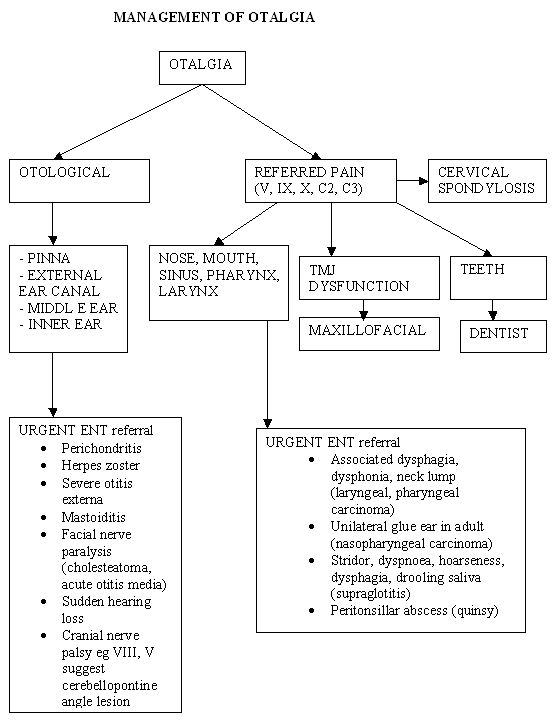|
|

 |
 |
|
Ten
minute consultation: Otalgia
|
 |
| |
|
Y Ramakrishnan
(MRCS, SHO ENT)
Ms A Rachmanidou (FRCS ORL HNS, Consultant
Otorhinolaryngologist)
Department of ENT and Audiology
University Hospital Lewisham, London
Yujay Ramakrishnan
C/o Ms A Rachmanidou
ENT Department
University Hospital Lewisham
Lewisham High Street
London SE13 6LH
|
Case
scenario
A 40 year old male patient
presents to you with persistent otalgia.
Lately he has been suffering from odynophagia
(painful swallowing). He is a lifelong smoker
and drinks heavily.
What issues to cover?
Otalgia is a common presentation in general
practice. It has many origins and distinguishing
otological from referred pain causes can
be done based on an accurate history and
examination. Otalgia may also sometimes
be the only symptom of underlying malignancy
and therefore should not be taken lightly.
- Onset and duration
of otalgia
- Associated otological
symptoms e.g. hearing loss, tinnitus and
vertigo. Unilateral, conductive type of
hearing loss (from glue ear) in an adult
may the sign of nasopharyngeal carcinoma.
- History of progressive
dysphagia, odynophagia, food sticking
in the throat and/or hoarseness and weight
loss suggests laryngopharyngeal lesion
e.g. tumours
- Fevers or rigors,
rapid onset and progression may be a sign
of an infective process e.g. tonsillitis,
peritonsillar abscess or supraglottitis.
- Smoking and alcohol
history has a strong associated with head
and neck cancers
- Referred pain can
originate from dental disease (Vth cranial
nerve), temporomandibular joint dysfunction
and cervical spondylosis (C2,C3 nerve)
|
|
What should you do?
Examination
Examine the ear
- Pinna- look for perichondritis,
vesicles (Herpes zoster)
- External auditory
canal- wax, debris/pus canal (otitis externa,
otitis media),
- Tympanic membrane-red
bulging drum (acute otitis media), perforation
(underlying cholesteatoma, chronic otitis
media), unilateral glue ear (nasopharyngeal
carcinoma)
- Postauricular swelling/tenderness
(Mastoiditis)
Head and neck examination
- Oral cavity,
tonsils, tongue and nose should all be
examined for infection or suspicious malignant
lesion
- Any neck swelling
should raise the suspicion of malignancy.
Of the head and neck neoplasms that present
as an isolated neck mass, 40% are due
to metastatic squamous carcinoma and 40%
are lymphomas.
- One should also examine
the dental status, temporomandibular joint
(TMJ) tenderness/clicking and cervical
tenderness and range of movement (spondylosis)
Treatment (see table)
- Any suspicion
of malignancy (history of smoking and
alcohol in a middle-aged person, persistent
hoarseness-duration>3 weeks, dysphagia)
should be referred to an ENT surgeon for
fibreoptic endoscopic examination.
- Features suggestive
airway compromise or inadequate oral intake
may suggest supraglottitis or tumour,
also need immediate referral.
- Sudden hearing
loss, facial paralysis, features or mastoidits
or suspicion of malignant otits externa
should be referred to ENT immediately.
- Acyclovir should
be started early in Ramsay Hunt syndrome
to prevent progression
- Dental or TMJ
dysfunction should be referred to the
dentist and maxillofacial surgeons respectively.
|
|

|
|
|
|
| 1. |
Key Topics
in Otolaryngology, 2nd Edition, NJ Roland,
RDR MacRae, AW McCombe p206-208 |
| 2. |
http://www.emedicine.com/ent/topic199.htm.
Otalgia, John Lee, Thomas W Ulrich |
| 3. |
Logan Turner's
Diseases of the Ear, Nose and Throat,
10th Edition, AGD Maran, p237-245 |
|
|
|
| |
|
|
|
|